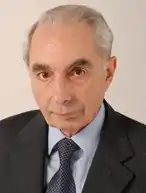18th G7 summit
The 18th G7 Summit was held in Munich, Germany between July 6 to 8, 1992. The venue for the summit meetings was at the Residenz palace in central Munich.[1]
| 18th G7 summit | |
|---|---|
 Wittelsbach palace in Munich, the Residenz | |
| Host country | Germany |
| Dates | July 6–8, 1992 |
| Follows | 17th G7 summit |
| Precedes | 19th G7 summit |
The Group of Seven (G7) was an unofficial forum which brought together the heads of the richest industrialized countries: France, Germany, Italy, Japan, the United Kingdom, the United States, Canada (since 1976)[2] and the President of the European Commission (starting officially in 1981).[3] The summits were not meant to be linked formally with wider international institutions; and in fact, a mild rebellion against the stiff formality of other international meetings was a part of the genesis of cooperation between France's President Giscard d'Estaing and West Germany's Chancellor Helmut Schmidt as they conceived the first Group of Six (G6) summit in 1975.[4]
Leaders at the summit

The G7 is an unofficial annual forum for the leaders of Canada, the European Commission, France, Germany, Italy, Japan, the United Kingdom and the United States.[3]
The 18th G7 summit was the first summit for Italian Prime Minister Giuliano Amato and Japanese Prime Minister Kiichi Miyazawa. It was also the last summit for Canadian Prime Minister Brian Mulroney and U.S. President George H.W. Bush.
Participants
These summit participants are the current "core members" of the international forum:[5][1][6]
| Core G7 members Host state and leader are shown in bold text. | |||
| Member | Represented by | Title | |
|---|---|---|---|
| Canada | Brian Mulroney | Prime Minister | |
| France | François Mitterrand | President | |
| Germany | Helmut Kohl | Chancellor | |
| Italy | Giuliano Amato | Prime Minister | |
| Japan | Kiichi Miyazawa | Prime Minister | |
| United Kingdom | John Major | Prime Minister | |
| United States | George H. W. Bush | President | |
| European Community | Jacques Delors | Commission President | |
| John Major | Council President | ||
Issues
The summit was intended as a venue for resolving differences among its members. As a practical matter, the summit was also conceived as an opportunity for its members to give each other mutual encouragement in the face of difficult economic decisions.[4] Issues which were discussed at this summit included:
- World Economy
- United Nations Conference on Environment and Development(UNCED)
- Developing Countries
- Central and Eastern Europe
- New Independent States of the Former Soviet Union
- Safety of Nuclear Power Plants in the New Independent States of the Former Soviet Union and in Central and Eastern Europe
Gallery
See also
Notes
- Japan, Ministry of Foreign Affairs (MOFA): Summit Meetings in the Past.. Accessed 2009-03-11. Archived 2009-04-30.
- Saunders, Doug. "Weight of the world too heavy for G8 shoulders," Archived 2009-04-29 at WebCite Globe and Mail (Toronto). July 5, 2008 -- n.b., the G7 becomes the Group of Eight (G7) with the inclusion of Russia starting in 1997.
- Reuters: "Factbox: The Group of Eight: what is it?", July 3, 2008.
- Reinalda, Bob and Bertjan Verbeek. (1998). Autonomous Policy Making by International Organizations, p. 205.
- Rieffel, Lex. "Regional Voices in Global Governance: Looking to 2010 (Part IV)," Archived 2010-06-03 at the Wayback Machine Brookings. March 27, 2009; "core" members (Muskoka 2010 G-8, official site). Archived 2010-06-02 at the Wayback Machine
- MOFA: Summit (18); European Union: "EU and the G8" Archived 2007-02-26 at the Wayback Machine
References
- Bayne, Nicholas and Robert D. Putnam. (2000). Hanging in There: The G7 and G8 Summit in Maturity and Renewal. Aldershot, Hampshire, England: Ashgate Publishing. ISBN 978-0-7546-1185-1; OCLC 43186692 (Archived 2009-04-29)
- Reinalda, Bob and Bertjan Verbeek. (1998). Autonomous Policy Making by International Organizations. London: Routledge. ISBN 978-0-415-16486-3; ISBN 978-0-203-45085-7; OCLC 39013643
External links
- No official website is created for any G7 summit prior to 1995 -- see the 21st G7 summit.
- University of Toronto: G8 Research Group, G8 Information Centre

.jpg.webp)
.jpg.webp)



.jpg.webp)
